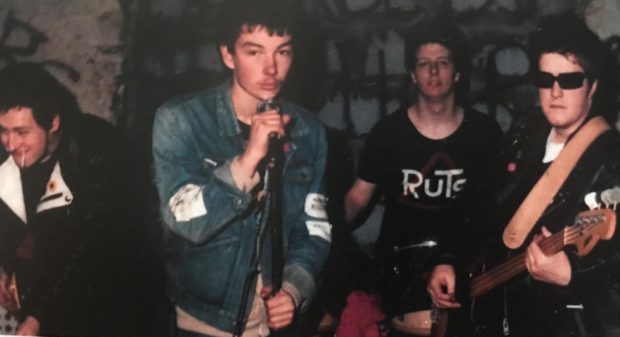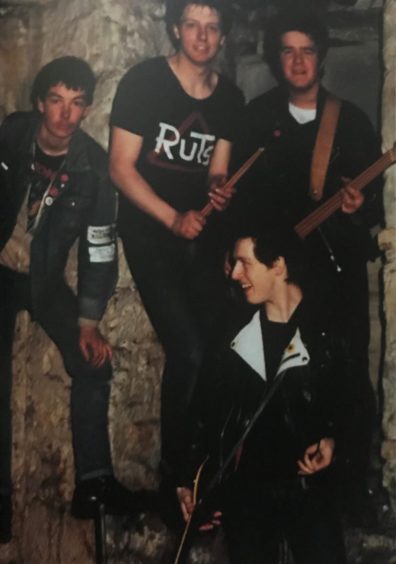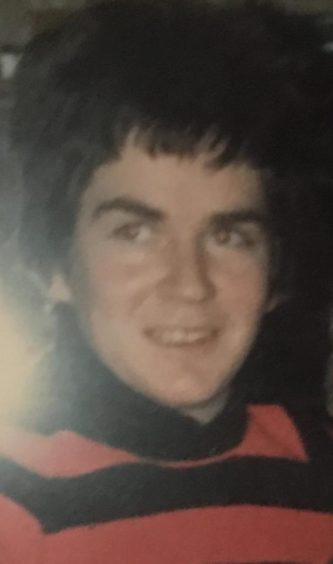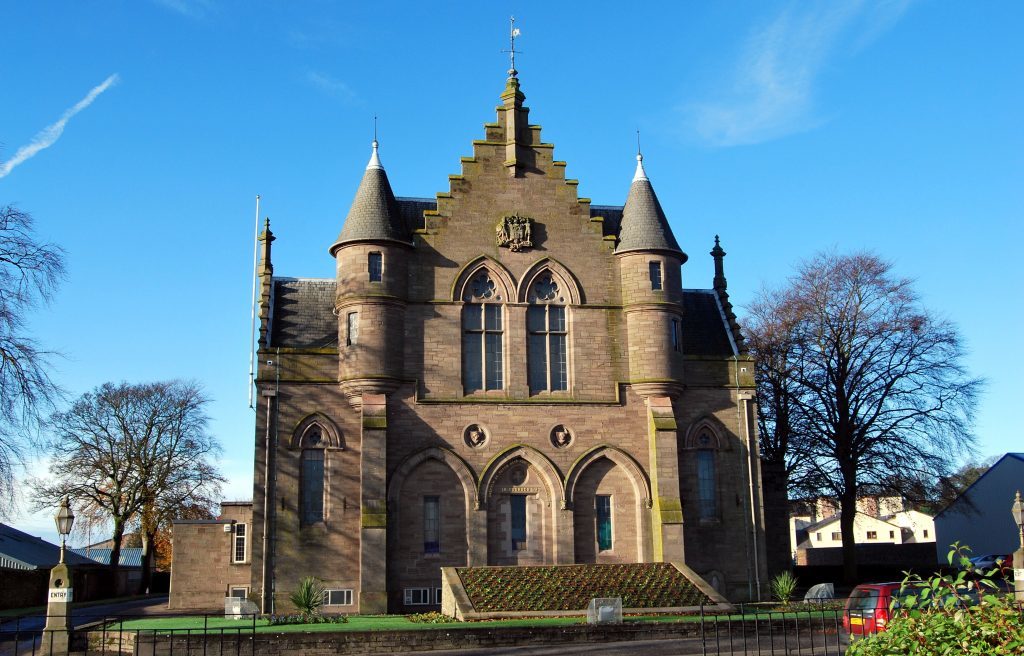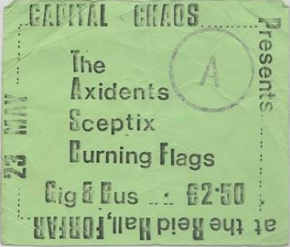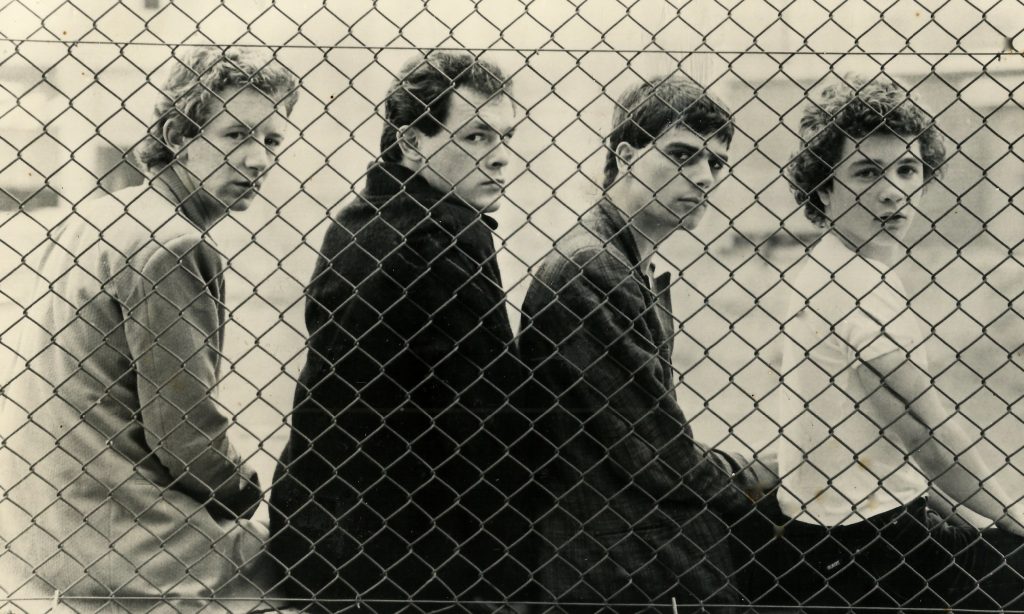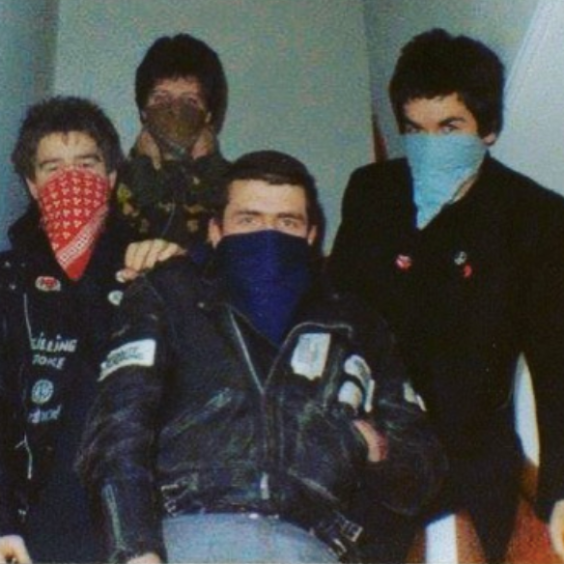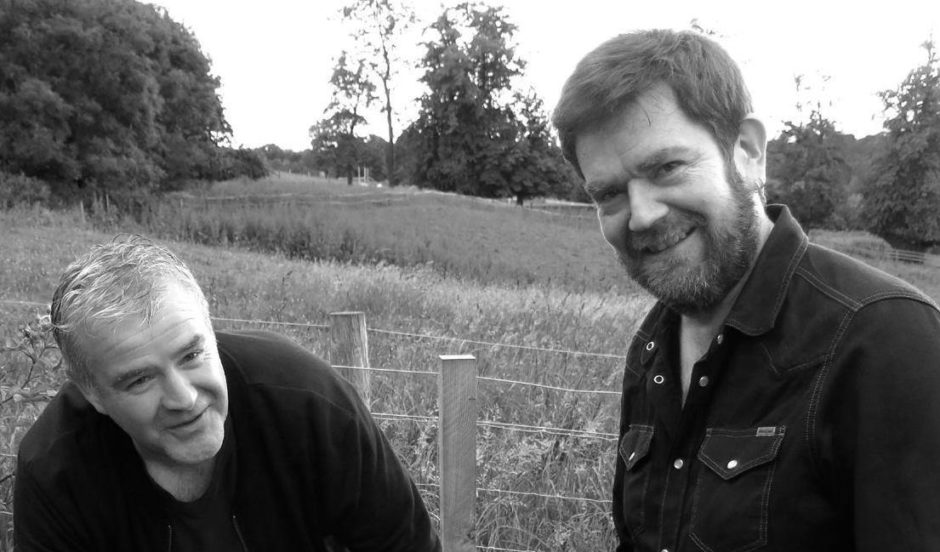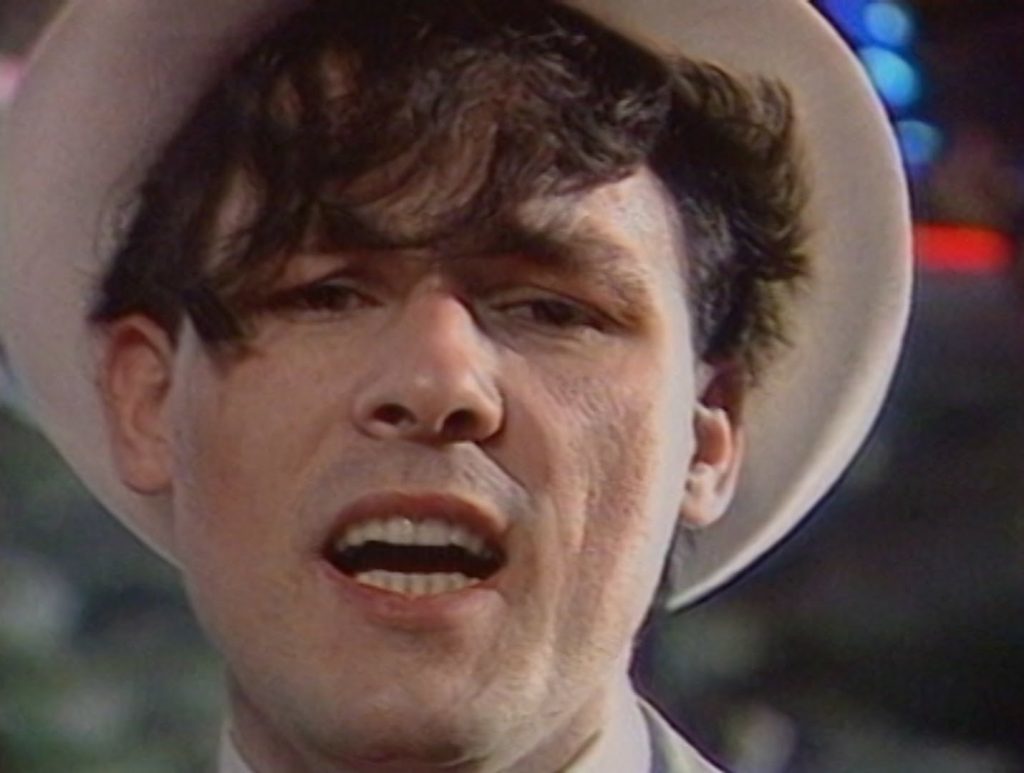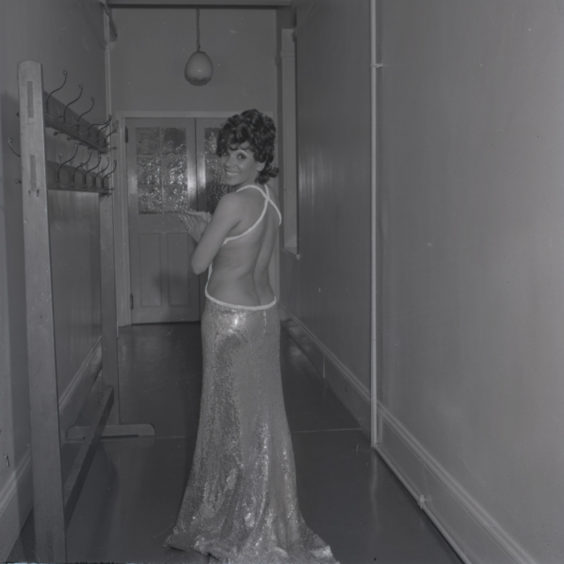It was the full-blown Forfar riot sparked by biker gangs which punk rockers still refer to as ‘the day the music died’.
Although 40 years have now passed, the memories of that night at the Reid Hall in May 1980 are difficult to shake off for those on the receiving end of the pint glasses and biker boots.
John Peel
Edinburgh-based The Axidents were championed by John Peel on his weekly BBC radio show and seemed destined for greater things before their meteoric rise was to crash and burn in the cruellest of circumstances.
Mark Fleming, a freelance writer who is still writing about Scotland’s post-punk scene, was only 17 at the time of the gig, and went along to support his old schoolmates who were playing in The Axidents.
Mark said: “Inspired by the Sex Pistols and The Clash a few years earlier, there was a healthy ‘post-punk’ scene in Scotland.
“Pubs, church halls, youth clubs and hotel bars would reverberate with the sound of angry young men and women, emulating ‘Anarchy in the UK’ or ‘White Riot’ with rock n’ roll outbursts of their own.
“In dingy basement rooms beneath Edinburgh’s medieval South Bridge, a host of groups would practice their songs, with youthful passion and enthusiasm making up for shortcomings in musicianship.
“Amongst these, The Exploited were destined for international fame while Scars would release several acclaimed singles and an album, and appear on the Old Grey Whistle Test.
“Amongst the lesser-known bands were a quartet – The Axidents, Twisted Nerve, Sceptix and Burning Flags – who played overtly political songs and often gigged together under the banner ‘Capital Chaos’.
“As was par for the course in those days, each band’s line-up fluctuated, but The Axidents reached a level of stability, not to mention musical proficiency, when a guitarist named Derek Reid joined.
“His mastery of the Gibson Les Paul was more reminiscent of the swagger of Steve Jones or Johnny Thunders than what often constituted ‘punk’ by 1980 which was buzzsaw riffs that made an impression on the eardrums but lacked originality.”
A coach was hired and the Capital Chaos bands and a bunch of their teenage fans travelled up the M90 to Forfar’s Reid Hall with The Axidents due to headline.
Capital chaos
“The cavernous interior of this 19th-century building, a former church, received an unlikely makeover, its large stage now cluttered with a motley assemblage of drum kits, mikes, guitar cases, amps with graffiti and backdrops hand-painted in the anarchist colours of red and black, and festooned in slogans,” said Mark.
“After short, blistering sets by Twisted Nerve and Burning Flags, Sceptix took to the stage.
“Ironically, given the ‘Capital Chaos’ moniker, the night was to degenerate into chaotic violence.
“As Sceptix launched into their set, the crowd began swelling inexplicably.
“But this had nothing to do with a sudden influx of local punks eager to catch these visiting bands.
“Having found out about this gig, Tayside biker gangs had descended on the Reid Hall, forcing their way inside.
“Masked by the dim lighting, the much older infiltrators began attacking random concert-goers, many of whom would have been at school earlier that day.
“In scenes reminiscent of the final Sex Pistols show in Texas, with guitars being swung at rednecks intent on attacking the musicians, the situation escalated into a full-blown riot.”
Because pint glasses were being launched towards the band, the heavy stage drapes were closed, while the terrified audience members clambered up and took shelter.
Human football
Mark said what happened next resembled a siege as assailants repeatedly tried climbing onto the stage, while the defenders fought them off with mike stands.
He said at one point he was dragged off the stage and ended up as a human football.
One of the gatecrashers also received a nasty injury when a cymbal was thrown like a martial arts weapon.
Punks who hid below the stage reported ominous sawing coming from the iron bars on the windows.
The mayhem continued for some time before the Forfar police arrived in large numbers to restore order.
The hall was cleared and the Capital Chaos coach received a blue light escort to the Tay Bridge, its every window smashed.
In the aftermath, Derek Reid decided to leave the band and joined The Associates as keyboard player before he became the band’s roadie and photographer.
End of the road
The Axidents went through further line-up changes, including welcoming ‘Big John’ Duncan on guitar before he went on to find fame with The Exploited and Goodbye Mr McKenzie.
He also worked as a guitar technician for Nirvana, performing with them in 1993.
But not long after the Forfar riot, The Axidents, who were formed at school in Gorgie two years before, decided to call it a day.
Following the split, bassist Ross Galloway and drummer Shug McKay recruited Mark and Toby Fraser to play guitar and sing for an experimental post-punk band called 4 Minute Warning.
They survived until the end of 1982.
“I’ve often wondered what would’ve happened to The Axidents,” said Mark.
“The Axidents recorded a demo a few weeks before Forfar and John Peel played a track on his show.
“Derek was a really accomplished guitarist which was one reason we were all taken aback when he jumped ship to become a keyboard player.
“His playing stood out like a sore thumb against many punk guitarists at the time, who could barely master three chords.
“To this day, on the odd occasion these former punks get together, at gigs, at the football, at parties or other social occasions, Forfar remains a taboo subject, referred to as ‘the F Word’, or ‘the day the music died.’”
After a lengthy hiatus, The Axidents reformed in 2001, becoming Desperation AM and are now recording under the name NONiCONIC.
Mark now writes about mental health and wellbeing after periods of hospitalisation in the 1980s.
His biography, BrainBomb, is imminent.
What happened to the other bands who played the Reid Hall that night?
Twisted Nerve continued, with various personnel changes, recording a session for John Peel’s radio show, later released as an EP in 1982.
By the mid-80s they had transitioned into a Goth band.
They have gigged intermittently ever since, and to this day enjoy a loyal following in Europe, playing at Goth festivals from Belgium to Poland.
Burning Flags went the way of many early 80s bands, running out of steam after the initial enthusiasm and momentum of the punk days.
But some of the band went on to become The Shattered Family in 1984, described as ‘Edinburgh’s post-punk psychedelic sensation, purveyors of the finest schizo-pop’.
Brothers Tam and Steve, respectively the singer and guitarist from Sceptix, went on to form Plague of Fools around 1983, heavily influenced by Killing Joke.
What became of the Associates?
Billy Mackenzie grew up in Stobswell in Dundee and travelled out to New Zealand when he was only 16 and the following year saw him in the United States where he was briefly married.
In 1976 he met Alan Rankine, a musician from Bridge of Allan, and the two formed a band which went through a number of name-changes before becoming The Associates in 1979.
The Dundee outfit unveiled themselves with their debut album ‘The Affectionate Punch’ in 1980.
Commercially, the band’s most successful year was 1982 with the success of the single ‘Party Fears Two’ whilst the album ‘Sulk’ was equally hailed as a masterpiece.
At the height of their success, Rankine left the band and as a commercial pop venture The Associates never really recovered.
Mackenzie carried on, not only with the name, but working as a solo artist and in partnership with many other individuals and groups.
He composed a song for Dame Shirley Bassey which was called The Rhythm Divine.
First released in 1987, Dame Shirley sings the vocals to this track in a collaboration with Swiss band Yello with backing vocals recorded by co-writer Mackenzie who worked with Yello on several occasions.
Dame Shirley flew over to Yello’s Zurich studio and recorded her vocals in under 40 minutes, arriving an hour late for the session.
“Working with Shirley Bassey made everything valid with my mum and aunties,” said Mackenzie at the time, whose backing vocals were overdubbed 90 times.
He was out of the limelight for the best part of 10 years but had signed with a new label and was working on an album when he took his own life on January 22 1997.
He was only 39.
